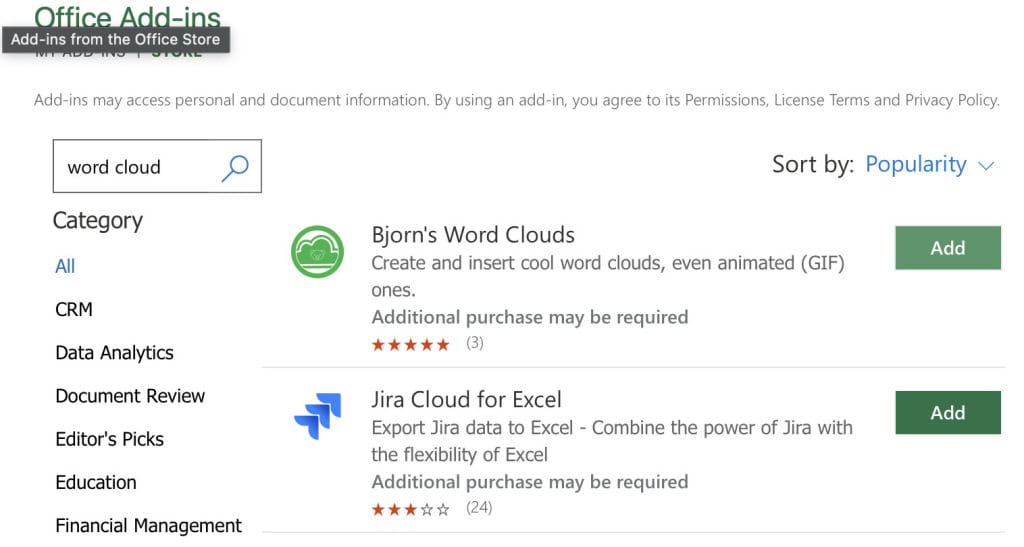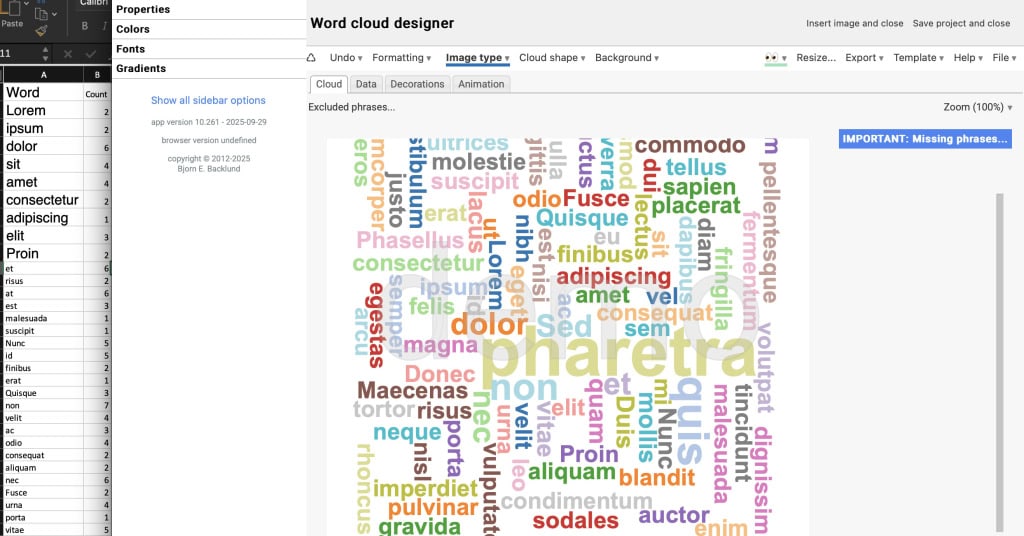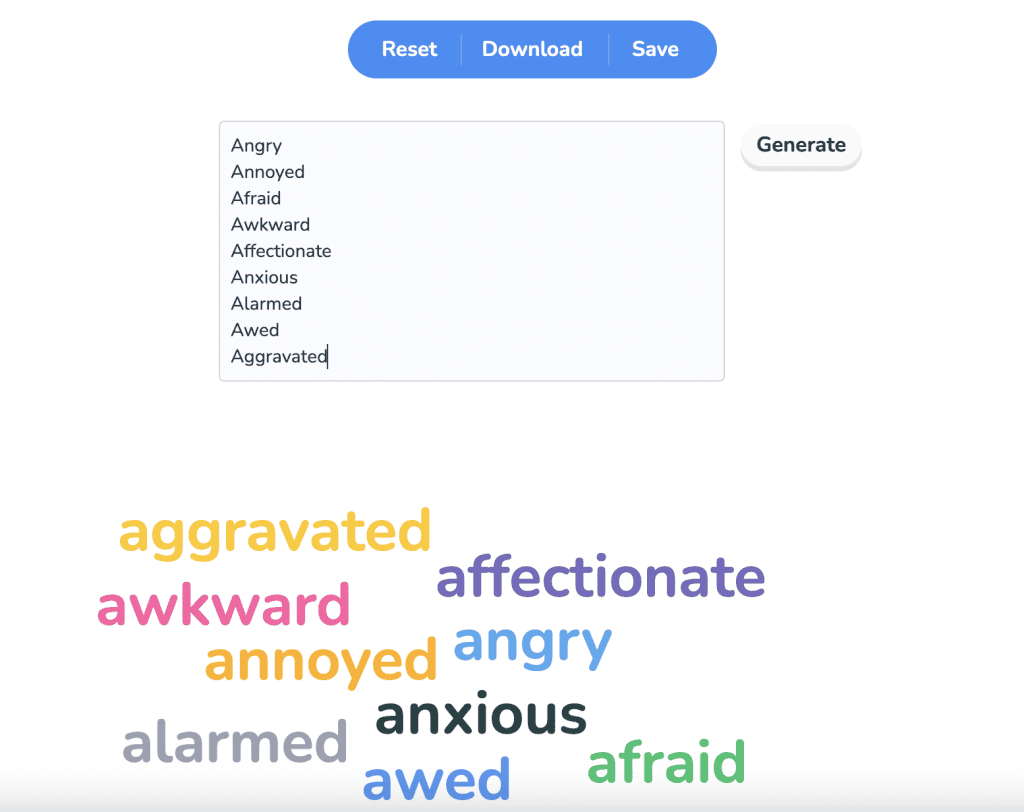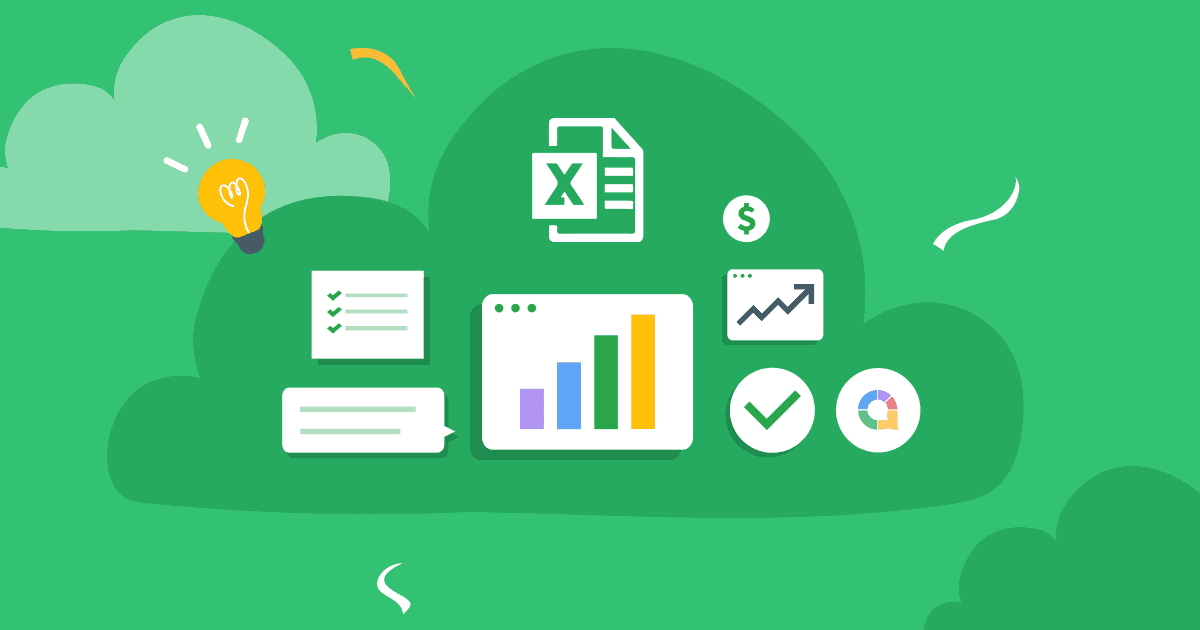Samtang ang Excel walay built-in nga word cloud feature, makahimo ka Excel word clouds dali gamiton ang bisan asa sa 3 nga mga teknik sa ubos:
Pamaagi 1: Gamita ang Excel add-in
Ang pinaka-integrated nga paagi mao ang paggamit sa usa ka add-in, nga nagtugot kanimo sa paghimo sa usa ka pulong nga panganod direkta sulod sa imong Excel spreadsheet. Usa ka popular ug libre nga kapilian mao ang Bjorn Word Cloud. Mahimo nimong pangitaon ang ubang mga gamit sa pulong sa panganod sa add-in nga librarya.
Lakang 1: Pag-andam sa imong data
- Ibutang ang tanan nga teksto nga gusto nimong analisahon sa usa ka kolum. Ang matag cell mahimong adunay usa o daghang mga pulong.
Lakang 2: I-install ang "Bjorn Word Cloud" add-in
- Lakaw ngadto sa Sal-ot tab sa laso.
- I-klik ang Pagkuha og mga Add-in.
- Sa Office Add-in store, pangitaa ang "Bjorn Word Cloud".
- I-klik ang Idugang buton sunod sa Pro Word Cloud add-in.

Lakang 3: Paghimo sa pulong nga panganod
- Lakaw ngadto sa Sal-ot tab ug i-klik Akong Add-in.
- Pagpili Bjorn Word Cloud aron maablihan ang panel niini sa tuo nga bahin sa imong screen.
- Ang add-in awtomatik nga makamatikod sa imong gipili nga hanay sa teksto. I-klik ang Paghimo usa ka pulong nga panganod button.

Lakang 4: Ipasibo ug i-save
- Ang add-in naghatag daghang mga kapilian aron ipasadya ang font, mga kolor, layout (horizontal, bertikal, ug uban pa), ug kaso sa imong mga pulong.
- Mahimo usab nimong i-adjust ang gidaghanon sa mga pulong nga gipakita ug i-filter ang kasagarang "stop words" (sama sa 'the', 'and', 'a').
- Ang pulong nga panganod makita sa panel. Mahimo nimong i-export kini isip SVG, GIF, o usa ka webpage.
Pamaagi 2: Gamit ug libre nga online word cloud generator
Kung dili nimo gusto nga mag-install usa ka add-in, mahimo nimong gamiton ang usa ka libre nga himan sa online. Kini nga pamaagi kasagaran naghatag og mas abante nga mga kapilian sa pag-customize.
Lakang 1: Pag-andam ug pagkopya sa imong data sa Excel
- I-organisar ang tanan nimong teksto sa usa ka kolum.
- I-highlight ang tibuok column ug kopyaha kini sa imong clipboard (Ctrl+C).
Lakang 2: Paggamit og online nga himan
- Pag-navigate sa usa ka libre nga pulong nga cloud generator website, sama sa AhaSlides nga word cloud generator, o https://www.google.com/search?q=FreeWordCloud.com.
- Pangitaa ang opsyon nga "Import" o "Paste Text".
- Idikit ang imong gikopya nga teksto gikan sa Excel sa gihatag nga kahon sa teksto.

Lakang 3: Paghimo, ipasibo, ug pag-download
- I-klik ang "Generate" o "Visualise" nga buton aron mahimo ang pulong nga panganod.
- Gamita ang mga himan sa website aron ipahiangay ang mga font, porma, kolor, ug oryentasyon sa pulong.
- Kung matagbaw ka, i-download ang pulong nga panganod ingon usa ka imahe (kasagaran PNG o JPG).
Pamaagi 3: Gamita ang Power BI
Kung naa kay Power BI nga andam sa imong desktop, kini mahimo nga usa ka maayo apan mas abante nga paagi sa pagmugna sa Excel word clouds kung kinahanglan nimo nga iproseso ang daghang mga pulong.
Lakang 1: Pag-andam sa imong data sa Excel
Una, kinahanglan nimo nga organisahon ang imong data sa teksto sa husto nga paagi sa usa ka sheet sa Excel. Ang sulundon nga format usa ka kolum diin ang matag cell adunay mga pulong o hugpong sa mga pulong nga gusto nimong analisahon.
- Paghimo og Column: Ibutang ang tanan nimong teksto sa usa ka kolum (eg, Kolum A).
- Format isip usa ka Talaan: Pilia ang imong data ug pindota Ctrl + T. Kini nag-format niini isip usa ka opisyal nga Talaan sa Excel, nga mas sayon nga basahon sa Power BI. Hatagi ang lamesa og klaro nga ngalan (pananglitan, "WordData").
- Luwasa imong Excel file.
Lakang 2: I-import ang imong Excel file sa Power BI
Sunod, ablihi ang Power BI Desktop (nga usa ka libre nga pag-download gikan sa Microsoft) aron makonektar sa imong Excel file.
- Ablihi ang Power BI.
- sa Home tab, i-klik Pagkuha Data Ug pagpili Excel Workbook.
- Pangitaa ug ablihi ang Excel file nga bag-o lang nimong gitipigan.
- sa Navigator bintana nga makita, susiha ang kahon sunod sa ngalan sa imong lamesa ("WordData").
- I-klik load. Ang imong datos karon makita sa Data pane sa tuo nga bahin sa Power BI nga bintana.
Lakang 3: Paghimo ug i-configure ang pulong nga panganod
Karon mahimo nimong tukuron ang aktwal nga biswal.
- Idugang ang biswal: sa Mga talan-awon pane, pangitaa ug i-klik ang Panganod sa pulong icon. Usa ka blangko nga template ang makita sa imong report canvas.
- Idugang ang imong data: Gikan sa Data pane, i-drag ang imong text column ug ihulog kini sa Kategoriya field sa Visualizations pane.
- Paghimo: Ang Power BI awtomatikong mag-ihap sa frequency sa matag pulong ug makamugna sa pulong cloud. Kon mas subsob ang usa ka pulong, mas dako kini nga makita.
Tips
- Limpyohi una ang imong data: kuhaa ang mga pulong sa paghunong (sama sa "ug", "ang", "mao"), punctuation, ug mga duplicate para sa mas klaro nga mga resulta.
- Kung ang imong teksto naa sa daghang mga cell, gamita ang mga pormula sama sa
=TEXTJOIN(" ",TRUE,A1:A50)aron mahiusa ang tanan sa usa ka cell. - Nindot kaayo ang Word clouds para sa visualization, pero ayaw ipakita ang eksaktong frequency counts—hunahunaa ang pagpares niini sa pivot table o bar chart para sa mas lawom nga pagtuki.





